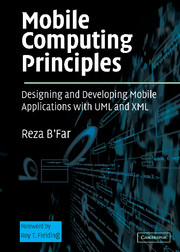Book contents
- Frontmatter
- Contents
- Foreword by Roy T. Fielding
- Acknowledgments
- SECTION 1 INTRODUCTIONS TO THE MAIN TOPICS
- SECTION 2 DEVICE-INDEPENDENT AND MULTICHANNEL USER INTERFACE DEVELOPMENT USING UML
- SECTION 3 ADDITIONAL DIMENSIONS OF MOBILE APPLICATION DEVELOPMENT
- SECTION 4 PUTTING THE PROJECT TOGETHER
- Chapter 15 The Mobile Development Process
- Chapter 16 Architecture, Design, and Technology Selection for Mobile Applications
- Chapter 17 Mobile Application Development Hurdles
- Chapter 18 Testing Mobile Applications
- Chapter 19 A Case Study
- References
- Index
Chapter 17 - Mobile Application Development Hurdles
from SECTION 4 - PUTTING THE PROJECT TOGETHER
Published online by Cambridge University Press: 03 September 2009
- Frontmatter
- Contents
- Foreword by Roy T. Fielding
- Acknowledgments
- SECTION 1 INTRODUCTIONS TO THE MAIN TOPICS
- SECTION 2 DEVICE-INDEPENDENT AND MULTICHANNEL USER INTERFACE DEVELOPMENT USING UML
- SECTION 3 ADDITIONAL DIMENSIONS OF MOBILE APPLICATION DEVELOPMENT
- SECTION 4 PUTTING THE PROJECT TOGETHER
- Chapter 15 The Mobile Development Process
- Chapter 16 Architecture, Design, and Technology Selection for Mobile Applications
- Chapter 17 Mobile Application Development Hurdles
- Chapter 18 Testing Mobile Applications
- Chapter 19 A Case Study
- References
- Index
Summary
Whatever one man is capable of conceiving, other men will be able to achieve.
Jules VerneINTRODUCTION
Much of the research done in software engineering is dedicated to solving practical problems that come up when building software applications. Techniques such as Extreme Programming and RUP are two such techniques and methodologies, addressing some of the issues associated with the process of building software applications.
The dimensions of mobility, as we have seen, add to the complexity of developing mobile applications. In this way, an entirely new set of hurdles and problems are introduced. In this chapter, we will briefly look at a few of these problems. Some of these problems will be addressable by the tools that we have introduced previously in this text; others will not.
Some of the basic hurdles are caused by the fact that most developers either have experience building call centers and other types of voice systems using the telephony channel or they build PC applications with GUIs. So, we will start by looking at hurdles associated with building a VUI for those developers who come from a server-side or GUI-based development background.
VOICE USER INTERFACE HURDLES
The first question that will come to your mind will be related to the infrastructure. This will be a hurdle in real deployments.
- Type
- Chapter
- Information
- Mobile Computing PrinciplesDesigning and Developing Mobile Applications with UML and XML, pp. 788 - 791Publisher: Cambridge University PressPrint publication year: 2004



